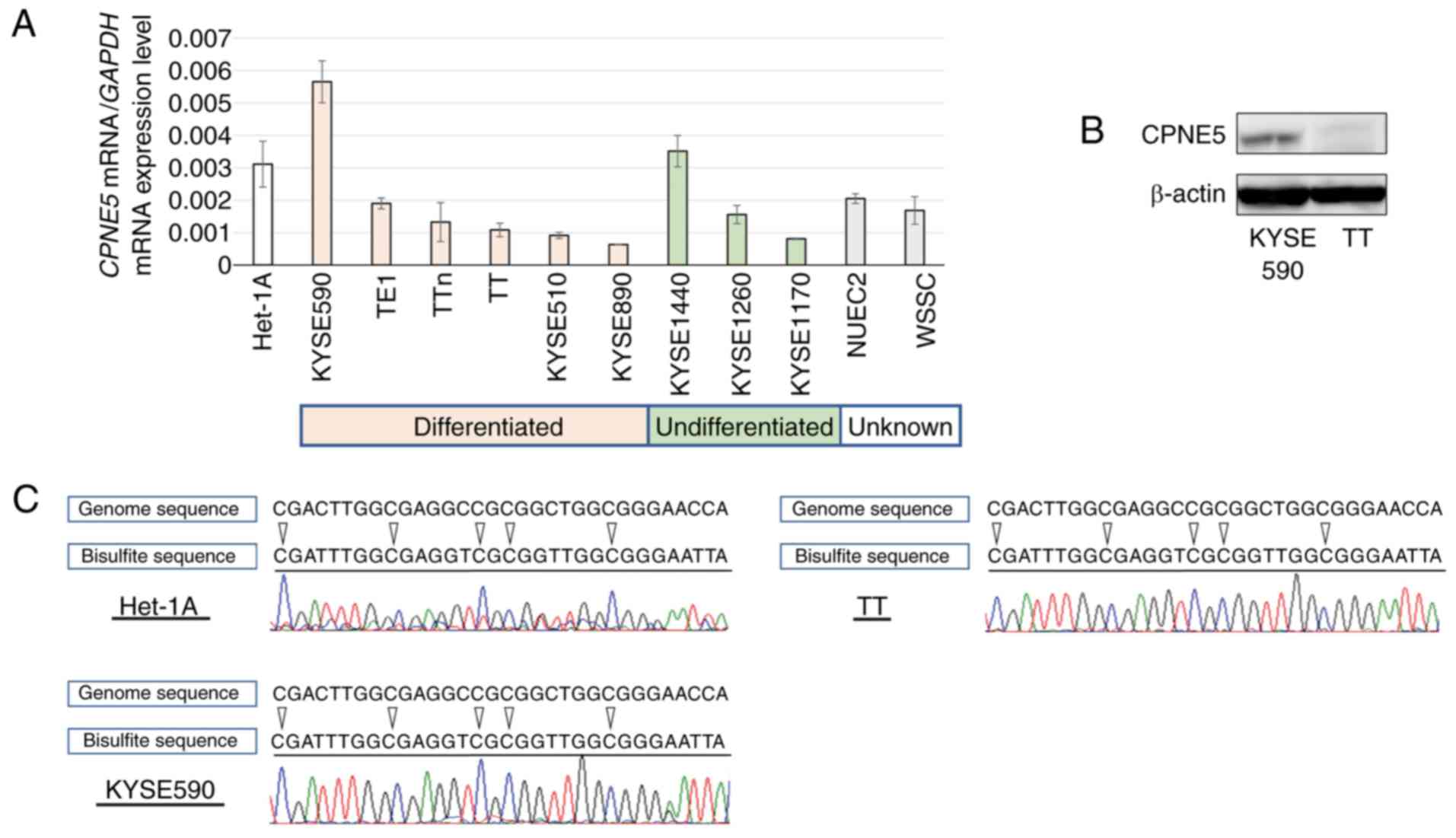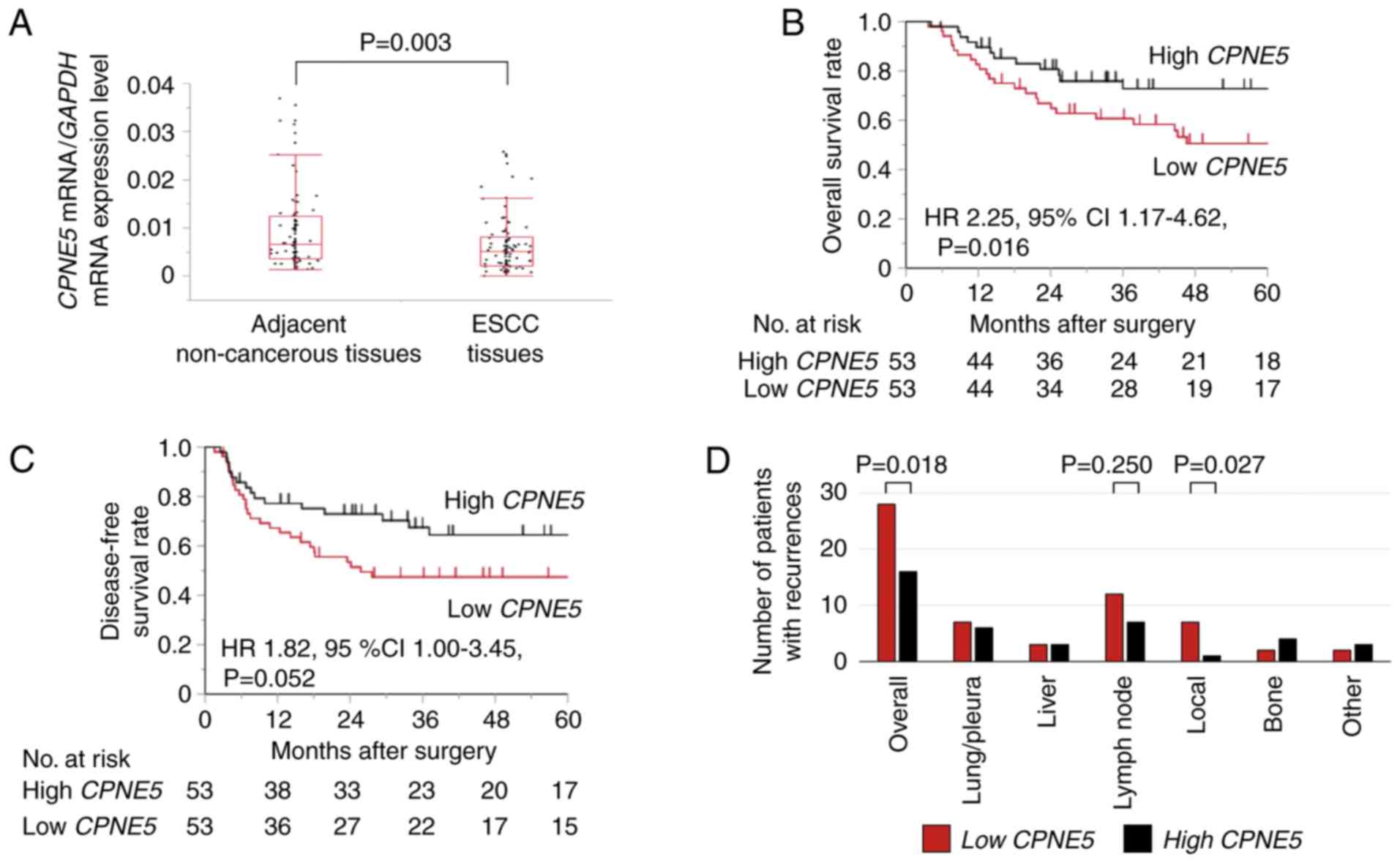|
1
|
Lagergren J, Smyth E, Cunningham D and
Lagergren P: Oesophageal cancer. Lancet. 390:2383–2396. 2017.
View Article : Google Scholar : PubMed/NCBI
|
|
2
|
Allemani C, Matsuda T, Di Carlo V,
Harewood R, Matz M, Nikšić M, Bonaventure A, Valkov M, Johnson CJ,
Estève J, et al: Global surveillance of trends in cancer survival
2000–14 (CONCORD-3): Analysis of individual records for 37 513 025
patients diagnosed with one of 18 cancers from 322 population-based
registries in 71 countries. Lancet. 391:1023–1075. 2018. View Article : Google Scholar : PubMed/NCBI
|
|
3
|
Tanaka H, Kanda M, Koike M, Iwata N,
Shimizu D, Ezaka K, Sueoka S, Tanaka Y, Takami H, Hashimoto R, et
al: Adherens junctions associated protein 1 serves as a predictor
of recurrence of squamous cell carcinoma of the esophagus. Int J
Oncol. 47:1811–1818. 2015. View Article : Google Scholar : PubMed/NCBI
|
|
4
|
Xi M, Yang Y, Zhang L, Yang H, Merrell KW,
Hallemeier CL, Shen RK, Haddock MG, Hofstetter WL, Maru DM, et al:
Multi-institutional analysis of recurrence and survival after
neoadjuvant chemoradiotherapy of esophageal cancer: Impact of
histology on recurrence patterns and outcomes. Ann Surg. 2018.
View Article : Google Scholar
|
|
5
|
Chen HS, Hsu PK, Liu CC and Wu SC: Upfront
surgery and pathological stage-based adjuvant chemoradiation
strategy in locally advanced esophageal squamous cell carcinoma.
Sci Rep. 8:21802018. View Article : Google Scholar : PubMed/NCBI
|
|
6
|
Hibino S, Kanda M, Oya H, Takami H,
Shimizu D, Nomoto S, Hishida M, Niwa Y, Koike M, Yamada S, et al:
Reduced expression of DENND2D through promoter hypermethylation is
an adverse prognostic factor in squamous cell carcinoma of the
esophagus. Oncol Rep. 31:693–700. 2014. View Article : Google Scholar : PubMed/NCBI
|
|
7
|
Kunzmann AT, McMenamin ÚC, Spence AD, Gray
RT, Murray LJ, Turkington RC and Coleman HG: Blood biomarkers for
early diagnosis of oesophageal cancer: A systematic review. Eur J
Gastroenterol Hepatol. 30:263–273. 2018.PubMed/NCBI
|
|
8
|
Tripodis N, Mason R, Humphray SJ, Davies
AF, Herberg JA, Trowsdale J, Nizetic D, Senger G and Ragoussis J:
Physical map of human 6p21.2-6p21.3: Region flanking the
centromeric end of the major histocompatibility complex. Genome
Res. 8:631–643. 1998. View Article : Google Scholar : PubMed/NCBI
|
|
9
|
Creutz CE, Tomsig JL, Snyder SL, Gautier
MC, Skouri F, Beisson J and Cohen J: The copines, a novel class of
C2 domain-containing, calcium-dependent, phospholipid-binding
proteins conserved from Paramecium to humans. J Biol Chem.
273:1393–1402. 1998. View Article : Google Scholar : PubMed/NCBI
|
|
10
|
Fagerberg L, Hallström BM, Oksvold P,
Kampf C, Djureinovic D, Odeberg J, Habuka M, Tahmasebpoor S,
Danielsson A, Edlund K, et al: Analysis of the human
tissue-specific expression by genome-wide integration of
transcriptomics and antibody-based proteomics. Mol Cell Proteomics.
13:397–406. 2014. View Article : Google Scholar : PubMed/NCBI
|
|
11
|
Ding X, Jin Y, Wu Y, Wu Y, Wu H, Xiong L,
Song X, Liu S, Fan W and Fan M: Localization and cellular
distribution of CPNE5 in embryonic mouse brain. Brain Res.
1224:20–28. 2008. View Article : Google Scholar : PubMed/NCBI
|
|
12
|
Wang KS, Zuo L, Pan Y, Xie C and Luo X:
Genetic variants in the CPNE5 gene are associated with alcohol
dependence and obesity in Caucasian populations. J Psychiatr Res.
71:1–7. 2015. View Article : Google Scholar : PubMed/NCBI
|
|
13
|
Kidger AM, Sipthorp J and Cook SJ: ERK1/2
inhibitors: New weapons to inhibit the RAS-regulated
RAF-MEK1/2-ERK1/2 pathway. Pharmacol Ther. 187:45–60. 2018.
View Article : Google Scholar : PubMed/NCBI
|
|
14
|
Hsieh FS, Hung MH, Wang CY, Chen YL, Hsiao
YJ, Tsai MH, Li JR, Chen LJ, Shih CT, Chao TI, et al: Inhibition of
protein phosphatase 5 suppresses non-small cell lung cancer through
AMP-activated kinase activation. Lung Cancer. 112:81–89. 2017.
View Article : Google Scholar : PubMed/NCBI
|
|
15
|
Schlessinger K, McManus EJ and Hall A:
Cdc42 and noncanonical Wnt signal transduction pathways cooperate
to promote cell polarity. J Cell Biol. 178:355–361. 2007.
View Article : Google Scholar : PubMed/NCBI
|
|
16
|
Tomsig JL, Snyder SL and Creutz CE:
Identification of targets for calcium signaling through the copine
family of proteins. Characterization of a coiled-coil
copine-binding motif. J Biol Chem. 278:10048–10054. 2003.
View Article : Google Scholar : PubMed/NCBI
|
|
17
|
Tsunoo H, Komura S, Ohishi N, Yajima H,
Akiyama S, Kasai Y, Ito K, Nakao A and Yagi K: Effect of
transfection with human interferon-beta gene entrapped in cationic
multilamellar liposomes in combination with 5-fluorouracil on the
growth of human esophageal cancer cells in vitro. Anticancer Res.
22:1537–1543. 2002.PubMed/NCBI
|
|
18
|
Shimada Y, Imamura M, Wagata T, Yamaguchi
N and Tobe T: Characterization of 21 newly established esophageal
cancer cell lines. Cancer. 69:277–284. 1992. View Article : Google Scholar : PubMed/NCBI
|
|
19
|
Miwa T, Kanda M, Koike M, Iwata N, Tanaka
H, Umeda S, Tanaka C, Kobayashi D, Hayashi M, Yamada S, et al:
Identification of NCCRP1 as an epigenetically regulated tumor
suppressor and biomarker for malignant phenotypes of squamous cell
carcinoma of the esophagus. Oncol Lett. 14:4822–4828. 2017.
View Article : Google Scholar : PubMed/NCBI
|
|
20
|
Sobin LH, Gospodarowicz MK and Wittekind
Ch: International Union Against CancerTNM Classification of
Malignant Tumours. 7th edition. Wiley-Blackwell; New York, NY: pp.
66–72. 2009
|
|
21
|
Kanda M, Shimizu D, Sueoka S, Nomoto S,
Oya H, Takami H, Ezaka K, Hashimoto R, Tanaka Y, Kobayashi D, et
al: Prognostic relevance of SAMSN1 expression in gastric cancer.
Oncol Lett. 12:4708–4716. 2016. View Article : Google Scholar : PubMed/NCBI
|
|
22
|
Shimizu D, Kanda M, Tanaka H, Kobayashi D,
Tanaka C, Hayashi M, Iwata N, Niwa Y, Takami H, Yamada S, et al:
GPR155 serves as a predictive biomarker for hematogenous metastasis
in patients with gastric cancer. Sci Rep. 7:420892017. View Article : Google Scholar : PubMed/NCBI
|
|
23
|
Livak KJ and Schmittgen TD: Analysis of
relative gene expression data using real-time quantitative PCR and
the 2−ΔΔCT method. Methods. 25:402–408. 2001. View Article : Google Scholar : PubMed/NCBI
|
|
24
|
Kanda M, Tanaka C, Kobayashi D, Tanaka H,
Shimizu D, Shibata M, Takami H, Hayashi M, Iwata N, Niwa Y, et al:
Epigenetic suppression of the immunoregulator MZB1 is associated
with the malignant phenotype of gastric cancer. Int J Cancer.
139:2290–2298. 2016. View Article : Google Scholar : PubMed/NCBI
|
|
25
|
Beck S, Rhee C, Song J, Lee BK, LeBlanc L,
Cannon L and Kim J: Implications of CpG islands on chromosomal
architectures and modes of global gene regulation. Nucleic Acids
Res. 46:4362–4391. 2018. View Article : Google Scholar
|
|
26
|
Pu W, Wang C, Chen S, Zhao D, Zhou Y, Ma
Y, Wang Y, Li C, Huang Z, Jin L, et al: Targeted bisulfite
sequencing identified a panel of DNA methylation-based biomarkers
for esophageal squamous cell carcinoma (ESCC). Clin Epigenetics.
9:1292017. View Article : Google Scholar : PubMed/NCBI
|
|
27
|
Kailasam A, Mittal SK and Agrawal DK:
Epigenetics in the pathogenesis of esophageal adenocarcinoma. Clin
Transl Sci. 8:394–402. 2015. View Article : Google Scholar : PubMed/NCBI
|
|
28
|
Dong G, Mao Q, Yu D, Zhang Y, Qiu M, Dong
G, Chen Q, Xia W, Wang J, Xu L, et al: Integrative analysis of copy
number and transcriptional expression profiles in esophageal cancer
to identify a novel driver gene for therapy. Sci Rep. 7:420602017.
View Article : Google Scholar : PubMed/NCBI
|
|
29
|
Chen XX, Zhong Q, Liu Y, Yan SM, Chen ZH,
Jin SZ, Xia TL, Li RY, Zhou AJ, Su Z, et al: Genomic comparison of
esophageal squamous cell carcinoma and its precursor lesions by
multi-region whole-exome sequencing. Nat Commun. 8:5242017.
View Article : Google Scholar : PubMed/NCBI
|
|
30
|
Zhang D, Zheng Y, Wang Z, Huang Q, Cao X,
Wang F and Liu S: Comparison of the 7th and proposed 8th editions
of the AJCC/UICC TNM staging system for esophageal squamous cell
carcinoma underwent radical surgery. Eur J Surg Oncol.
43:1949–1955. 2017. View Article : Google Scholar : PubMed/NCBI
|
|
31
|
Zhang SS, Yang H, Xie X, Luo KJ, Wen J,
Bella AE, Hu Y, Yang F and Fu JH: Adjuvant chemotherapy versus
surgery alone for esophageal squamous cell carcinoma: A
meta-analysis of randomized controlled trials and nonrandomized
studies. Dis Esophagus. 27:574–584. 2014. View Article : Google Scholar : PubMed/NCBI
|
|
32
|
Wu SG, Zhang WW, He ZY, Sun JY, Chen YX
and Guo L: Sites of metastasis and overall survival in esophageal
cancer: A population-based study. Cancer Manag Res. 9:781–788.
2017. View Article : Google Scholar : PubMed/NCBI
|
|
33
|
Guo JC, Lin CC, Huang TC, Huang PM, Kuo
HY, Chang CH, Wang CC, Cheng JC, Yeh KH, Hsu CH, et al: Number of
resected lymph nodes and survival of patients with locally advanced
esophageal squamous cell carcinoma receiving preoperative
chemoradiotherapy. Anticancer Res. 38:1569–1577. 2018.PubMed/NCBI
|
|
34
|
Tam PC, Siu KF, Cheung HC, Ma L and Wong
J: Local recurrences after subtotal esophagectomy for squamous cell
carcinoma. Ann Surg. 205:189–194. 1987. View Article : Google Scholar : PubMed/NCBI
|
|
35
|
Catalano MF, Sivak MV Jr, Rice TW and Van
Dam J: Postoperative screening for anastomotic recurrence of
esophageal carcinoma by endoscopic ultrasonography. Gastrointest
Endosc. 42:540–544. 1995. View Article : Google Scholar : PubMed/NCBI
|
|
36
|
Kim TJ, Lee KH, Kim YH, Sung SW, Jheon S,
Cho SK and Lee KW: Postoperative imaging of esophageal cancer: What
chest radiologists need to know. Radiographics. 27:409–429. 2007.
View Article : Google Scholar : PubMed/NCBI
|

















